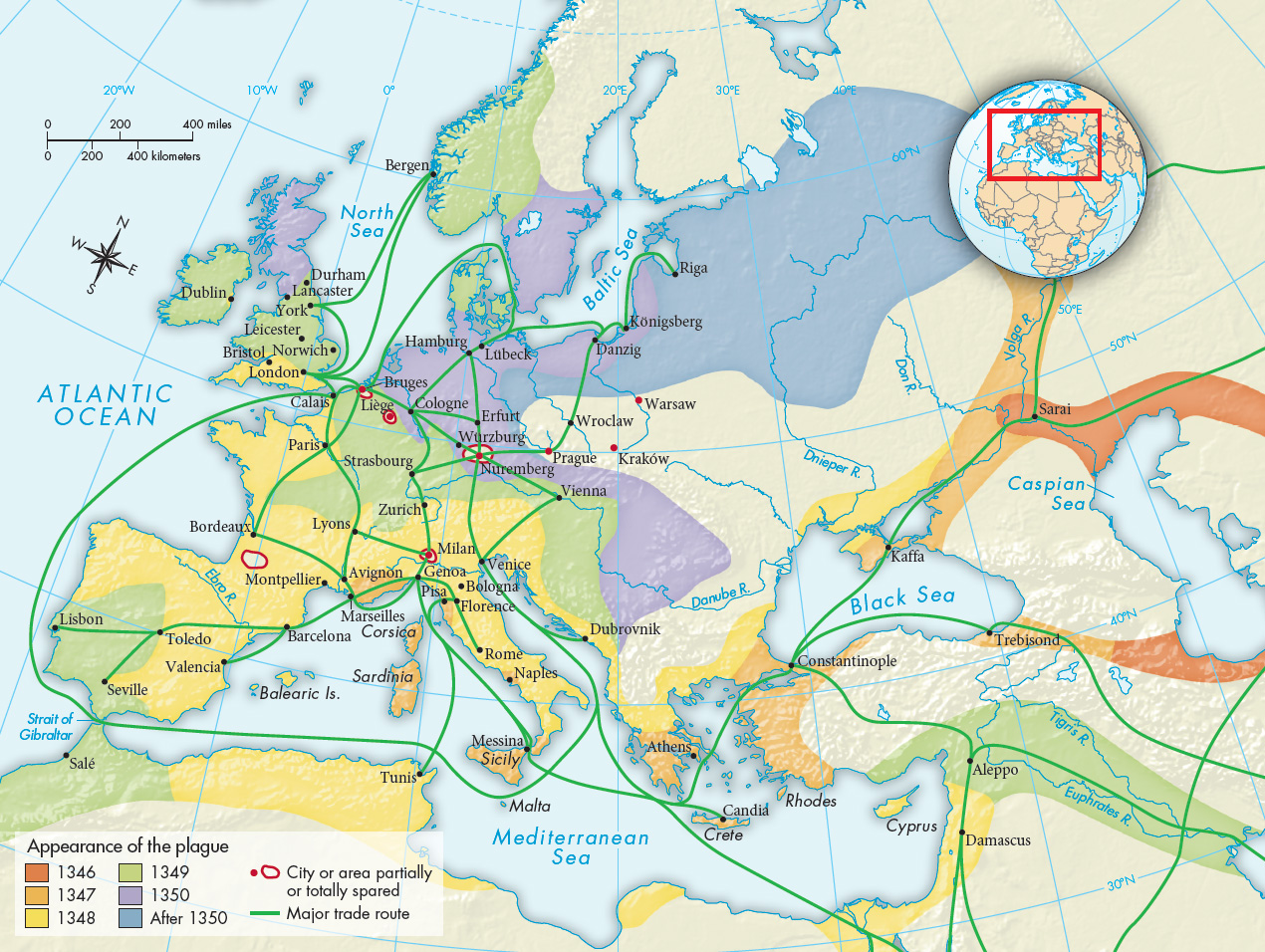A History of Western Society: Printed Page 326
A History of Western Society, Value Edition: Printed Page 335
Spread of the Disease
Plague symptoms were first described in 1331 in southwestern China, then part of the Mongol Empire. Plague-infested rats accompanied Mongol armies and merchant caravans carrying silk, spices, and gold across Central Asia in the 1330s. The rats then stowed away on ships, carrying the disease to the ports of the Black Sea by the 1340s. One Italian chronicler told of more dramatic means of spreading the disease as well: Mongol armies besieging the city of Kaffa on the shores of the Black Sea catapulted plague-infected corpses over the walls to infect those inside. The city’s residents dumped the corpses into the sea as fast as they could, but they were already infected.
In October 1347 Genoese ships brought the plague from Kaffa to Messina, from which it spread across Sicily. Venice and Genoa were hit in January 1348, and from the port of Pisa the disease spread south to Rome and east to Florence and all of Tuscany. By late spring southern Germany was attacked. Frightened French authorities chased a galley bearing plague victims away from the port of Marseilles, but not before plague had infected the city, from which it spread to southern France and Spain. In June 1348 two ships entered the Bristol Channel and introduced it into England, and from there it traveled northeast into Scandinavia. The plague seems to have entered Poland through the Baltic seaports and spread eastward from there (Map 11.1).
Medieval urban conditions were ideal for the spread of disease. Narrow streets were filled with refuse, human excrement, and dead animals. Houses whose upper stories projected over the lower ones blocked light and air. Houses were beginning to be constructed of brick, but many wood, clay, and mud houses remained. A determined rat had little trouble entering such a house. In addition, people were already weakened by famine, standards of personal hygiene remained frightfully low, and the urban populace was crowded together. Fleas and body lice were universal afflictions: everyone from peasants to archbishops had them. One more bite did not cause much alarm, and the association between rats, fleas, and the plague was unknown. Mortality rates can be only educated guesses because population figures for the period before the arrival of the plague do not exist for most countries and cities. Of a total English population of perhaps 4.2 million, probably 1.4 million died of the Black Death. Densely populated Italian cities endured incredible losses. Florence lost between one-half and two-thirds of its population when the plague visited in 1348. Islamic parts of Europe were not spared, nor was the rest of the Muslim world. The most widely accepted estimate for western Europe and the Mediterranean is that the plague killed about one-third of the population in the first wave of infection. (Some areas, including such cities as Milan, Liege, and Nuremberg, were largely spared, primarily because city authorities closed the gates to all outsiders when plague was in the area, and enough food had been stored to sustain the city until the danger had passed.)
Nor did central and eastern Europe escape the ravages of the disease. One chronicler records that, in the summer and autumn of 1349, between five hundred and six hundred died every day in Vienna. As the Black Death took its toll on the Holy Roman Empire, waves of emigrants fled to Poland, Bohemia, and Hungary, taking the plague with them. In the Byzantine Empire the plague ravaged the population. The youngest son of Emperor John VI Kantakouzenos died just as his father took over the throne in 1347. “So incurable was the evil,” wrote John later in his history of the Byzantine Empire, “that neither any regularity of life, nor any bodily strength could resist it. Strong and weak bodies were all similarly carried away, and those best cared for died in the same manner as the poor.”1
Across Europe the Black Death recurred intermittently from the 1360s to 1400. It reappeared from time to time over the following centuries as well, though never with the same virulence because by then Europeans now had some resistance. Improved standards of hygiene and strictly enforced quarantine measures also lessened the plague’s toll, but only in 1721 did it make its last appearance in Europe, in the French port of Marseilles. And only in 1947, six centuries after the arrival of the plague in Europe, did the American microbiologist Selman Waksman discover an effective treatment, streptomycin. Plague continues to infect rodent and human populations sporadically today.

MAPPING THE PAST
ANALYZING THE MAP When did the plague reach Paris? How much time passed before it spread to the rest of northern France and southern Germany? Which cities and regions were spared?
CONNECTIONS How did the expansion of trade contribute to the spread of the Black Death?